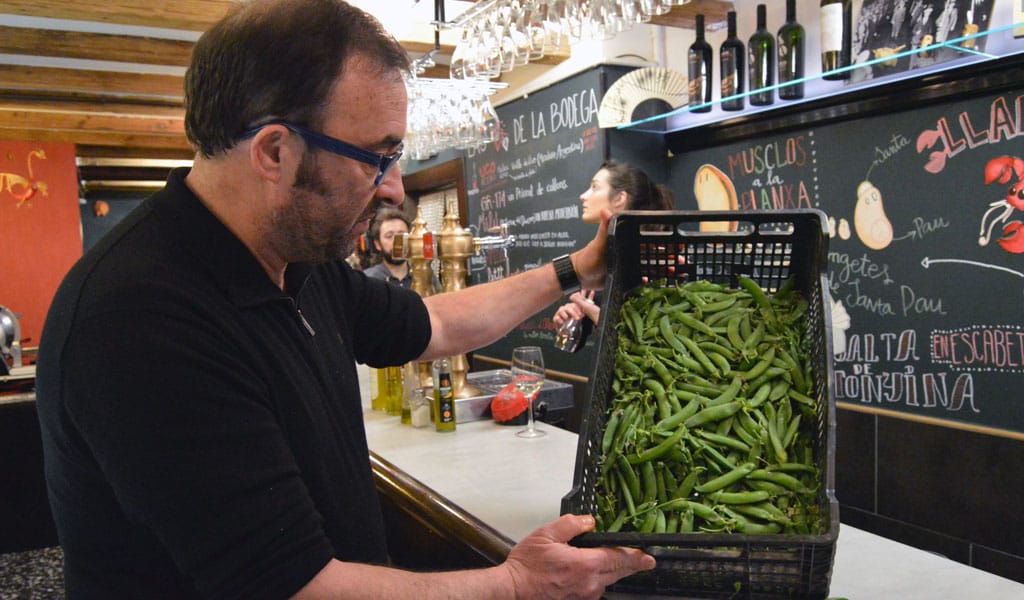It’s Sunday morning at La Pignasecca market in Naples and time is in flux. Picture a Boccioni painting: movement is blurred, there is an inter-penetration of objects, speeding vehicles and sound – a frenetic moment in the Futurists’ imagination. The city rises as engines splutter, traders hustle, klaxons yelp.
Santa Maria di Montesanto spews punters out into the marketplace after mass; men peel off, heading home to check on the simmering ragù; groomed teenagers peacock on mopeds as groups of women push in line to pick up their last-minute order of fresh pasta, charcuterie and squid. The church bells chime: it’s lunchtime. Anticipation is in the air.
La Pignasecca in Montesanto is the oldest marketplace in the center of Naples. “The dried pine” owes its name to the last tree that stood at the entrance to the extensive vegetable gardens that once fed hungry inner-city bellies. When the land was developed to house the occupying Spanish garrisons in 1500, only this lone withered tree avoided the axe. It reinvented itself as a hangman’s cross. Convicted criminals swung from the tree, issuing a warning to outlanders as they entered through the ancient city gates of Port’Alba. The branches were also rumored to have served as a nifty treasure chest for magpies to hide stolen jewels plucked from the houses of the Spanish viceroys. La Pignasecca no longer hosts vegetable plots but remains a gem in the Neapolitan foodscape nonetheless, especially on Sundays when the stores at the feet of the decaying Spanish palazzi spill forth their produce.
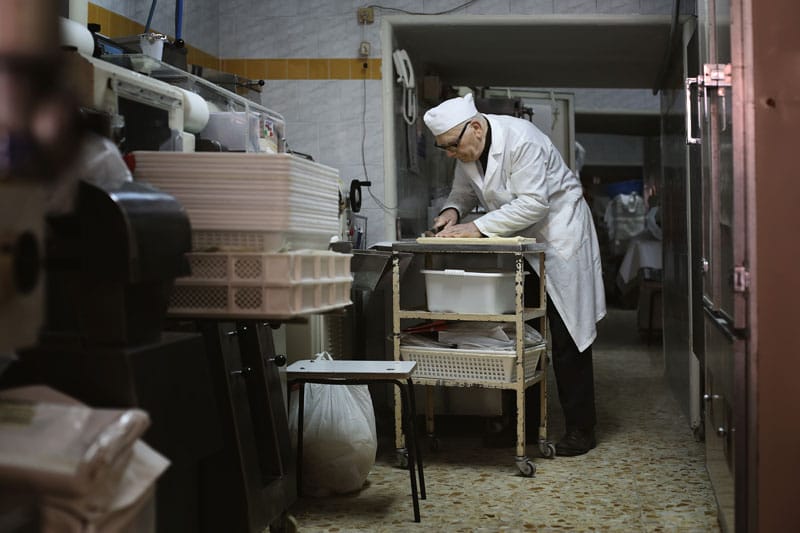
In Montesanto, deviation from weekly routine is rare. After church, families feast together while watching Napoli play football on TV. It’s eating that shapes routine for Neapolitans, and Sundays are sacred. The standard menu starts with cured hams and smoked provola cheese, followed by pasta al ragù napoletana and then frittura (a deep-fried selection of squid, anchovies and prawns), capped off by a chaser of nonna’s limoncello. In addition, visiting cousins and older siblings are duty-bound to bring a tray of freshly baked pastries finely wrapped in reflective cellophane and a curling bow. Each tart hand-selected from their bakery of choice comes oozing with cream, ricotta or Nutella and a sprinkle of icing sugar. All these treats must be bought fresh at the market after church.
Every family has their grocer di fiducia where they always buy their produce. It’s their trusty enclave of the market where after years of patronage they are rewarded with the freshest food in stock and the best prices. Locals are distinctly proud of these places. Ask anyone for a recommendation, and they will emphatically send you on your way with a message for the owner – Gennaro has recommended I come here – to which you will be greeted with a commotion of kindness and a lifetime of good deals. You can thank Gennaro later for the years of laying the groundwork before your arrival in the neighborhood.
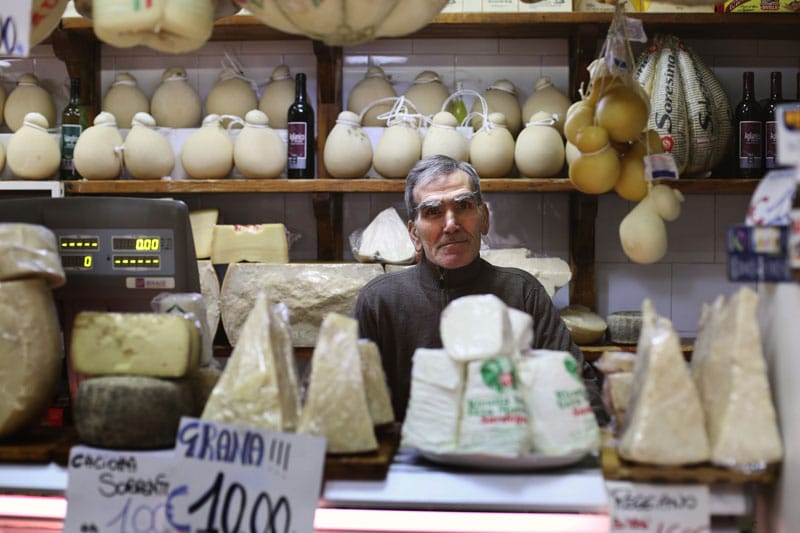
In Montesanto the queue outside Salumeria ai Monti Lattari is enough evidence to suggest that this is one of those trusted local establishments. It’s the milky provola, handmade that morning in a caseificio in the hills above Sorrento, for which this deli is well known. In fact, the dairy and the deli share a historically close relationship. “Our grandfathers were the founders of these places,” explains Eva, the youngest daughter of the Monti Lattari lineage. Her father Sig. Galozzi began working here at the age of eight and can still be found scaling a stepladder to adjust the hanging provolone that replicate the multiple breasts adorning the statue of Goddess Artemis dug up in nearby Pompeii.
Keeping things in the family and on a small scale can be beneficial when a reputation precedes you and there are children willing to take it over. However, keeping up with the fast-paced consumer habits of recent times can be a trickier task. The proprietors of Il Mattarello d’Oro (The Golden Rolling Pin) run the oldest functioning pasta kitchen in the city. With a lifetime of experience and a passion for good quality, their trade epitomizes the old-guard merchant class of Bourbon Naples. Congestion charges have kept away customers who used to collect big orders by car, and pre-packaged pasta that’s now readily available at a fraction of the cost has meant that daily sales have weakened. What sustains places like these in Naples is the tendency for Neapolitans to stick to their gastronomic weekly routine. This tiny shop, in the corner of the market, will always be thriving on weekends as the neighborhood signore with more time on their hands cram in to pick up their beautifully wrapped trays of cannelloni or tortelloni.
Walking into Il Mattarello d’Oro is like walking into a scene from the middle of the 20th century, from the handwritten recipes in see-through plastic wallets taped to the wall to the dated equipment still in use there. “Unlike modern appliances, these sturdy motorized machines haven’t needed to be fixed in 45 years,” says the proud 84-year-old owner. All the pasta is made in the narrow galley kitchen. Behind him the mechanical machines spit out perfectly formed gnocchi or delicate thin sheets of lasagna, while his wife makes sure the machines are well fed with ingredients of optimum quality.
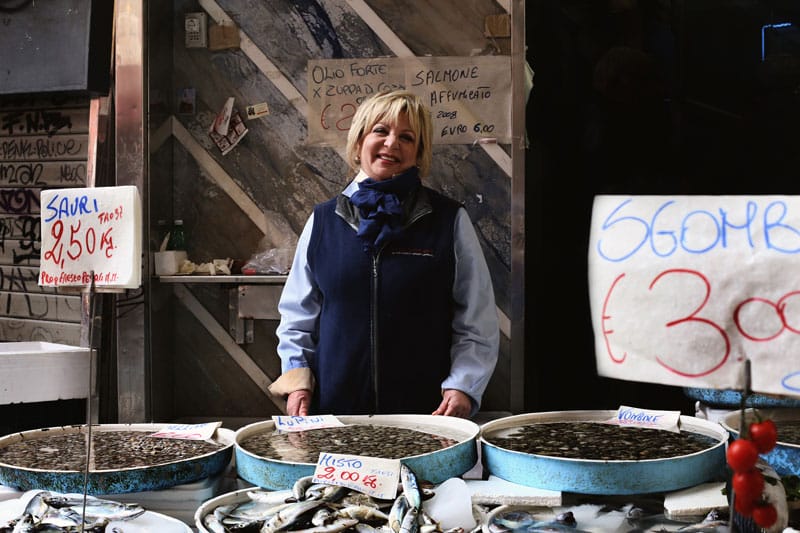
One person who doesn’t have to worry about losing customers in Montesanto is Carmella Gagliotta at La Pescaria Azzurra. Carmella has worked at the fish market her whole life along with her six brothers and her parents. Buxom and aged, she displays all the signs of a Neapolitan working-class girl who’s been graced with wealth: Botox, bleach and a long-term tan. “We are revered as the best in the whole city,” she boisterously reminds us as we eat pastries in her gold gilded flat above the market.
It started simply though. Her mother used to board the light railway to Pozzuoli fish market to the east of the city, where the Romans built the first commercial fishing port. Mamma Gagliotta would return home with a basket of fresh catch balanced on her head to sell from a small shop window in La Pignasecca. Today, La Pescaria Azzura makes the market a destination even for Neapolitans from satellite neighborhoods. In its current form the fishmonger spills out over an entire block with cylindrical containers of water brimming with live lobster, fresh seabass and spitting clams. Carmella conducts business from her till and decides which loyal customers to reward with a discount and who to overcharge. She recently made it possible to savor fried fish and cockles snapped straight from the market next door, seducing an increasing trickle of tourists.
Cheese, fish and pasta are worshipped foods found covering the table at Sunday lunch, consumed as if in a ritual in devotion to the abundance of locally grown produce. If elsewhere the tag “locally sourced” has become a bourgeois fetish, here it remains a feature of working-class consumption and necessity, largely reflected in the price. After all it was only after Pellegrino Artusi in the late 19th century unified the peninsula’s diverse gastronomic culture into one bulging cookbook that markets began to stock produce from other parts of Italy and to have the same names for foods in the south as in the north. Still today, by-products of globalization, such as avocados or mangos and anything out of season, are difficult to find.
La Pignasecca offers relief for anyone in fear of the homogenization of street life and corporate rule elsewhere in Europe. These three stores – Ai Monti Lattari, Il Matterello D’Oro and La Pescaria Azzura – defy 21st-century urban logic. They are independent and family run yet still make visible their mark within the fabric of the community.
The parish church that overlooks these shops is also a central pillar in this Naples hamlet. It’s run by an order of friars that makes “community, prayer and service” integral to their liturgical doctrine. Today these religious tropes are remarkably reflected and repeated habitually in this busy Montesanto market square. Church revelers, done with prayer, mingle in their community before sitting down to a sacred service of a five-course Sunday lunch.
 June 13, 2018 Matosinhos
June 13, 2018 Matosinhos
Matosinhos, a small city just north of Porto, is used to change.
It has an industrial […] Posted in Porto April 5, 2018 Spring Fever
April 5, 2018 Spring Fever
Barcelona’s urban sprawl makes it easy to forget that the city is adjacent to two […] Posted in Barcelona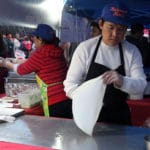 June 7, 2017 Queens International Night Market
June 7, 2017 Queens International Night Market
Something special happens when the sun goes down. Night markets, whether in Southeast […] Posted in Queens
Published on March 28, 2017
Related stories
Sample some of Porto’s seafood delicacies on our walk!
June 13, 2018
PortoMatosinhos, a small city just north of Porto, is used to change. It has an industrial air to it, due to its 19th-century harbor, and its past prosperity was connected to the fish-canning sector, which peaked during World War II and declined from the beginning of the 70s. The numerous abandoned warehouses attracted nightlife during…
Come see what Spring is all about, on our Sants tour.
April 5, 2018
BarcelonaBarcelona’s urban sprawl makes it easy to forget that the city is adjacent to two fertile regions to the north and south, El Maresme and El Baix Llobregat, which provide numerous hyperlocal culinary treasures throughout the year. In spring as in other seasons, these treasures appear at markets and restaurants, their origins proudly displayed, sometimes…
Take a deep dive into the bounty of Queens on our culinary walk in this area.
June 7, 2017
QueensSomething special happens when the sun goes down. Night markets, whether in Southeast Asia or in the heart of Queens, inspire a thrill — we call it a sense of wonder — that brings boundless childhood summers to mind. We still feel it, on warm-weather Saturdays, when we ride the elevated 7 train to the…















































